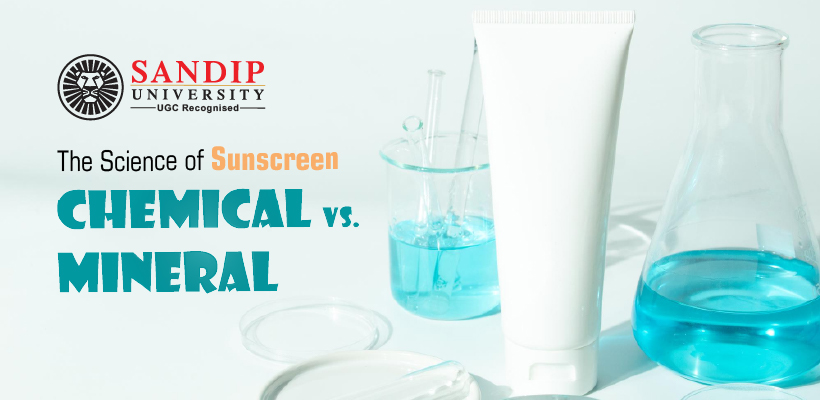Screen has now become an essential part of life; people are becoming aware of its importance. Wearing sunscreen is one of the best and the easiest ways to protect our skin and keep it healthy. Using it regularly can help prevent skin burns, premature aging, and skin cancer. Some of the top beauty cosmetology colleges in Maharashtra are conducting path-breaking research to develop safe and effective sunscreen options to protect against the harsh UV rays.
But first we need to know what sunscreen does exactly. Sunscreen has something called SPF which means Sun Protection Factor it represents a sunscreen’s ability to protect against UV rays. To understand it better, there are 3 types of UV radiation UVC, UVB, and UVA. Let’s get UVC out of the way as it is absorbed by 100% of UVC. But a little bit of UVB escapes the ozone layer but 90% of it is absorbed. But UVA is not absorbed or very minimally. This radiation by UVA penetrates the skin and produces free radicles damaging the DNA. On the other hand, UVB causes sunburn and DNA strand breaks, leading to pyrimidine dimer mutations linked to non-melanoma skin cancers and as we have all heard about broad spectrum sunscreens it means it will protect from both UVA and UVB rays.
For the day-to-day thing SPF 30 works well, if you spend more time outdoors choose SPF 60. Let us take a closer look at the different kinds of sunscreen and the pros and cons of each:
Sunscreen
When we talk about sun protection or photoprotection it consists of primary and secondary factors. The primary factors are sunscreens which are a physical barrier that reflect, and scatter light and chemical barriers absorb light. The secondary factors are antioxidants, osmolytes and DNA repair enzymes which help to limit skin damage caused by UV sunlight.
Chemical VS Mineral Sunscreens
Hold on the physical barriers are also divided into 2 types of chemical and mineral based sunscreens.
First let’s see chemical sunscreens, they are also known as organic sunscreens. They usually consist of UVA and UVB blockers. How it works is that it absorbs the UV spectrum. Usually, the whole of UVB and a part of UVA radiation. Lets see a few examples of chemical based UVB blockers they usually protect against short wavelength UV radiation which causes sun burn. A Few examples are:
- Aminobenzoates
- Cinnamates
- Salicylates
- Octocrylene
- Ensulizole
- Camphor derivatives
Now UVA blockers, they usually protect against long wavelength radiation that penetrates deeper causing photoaging, hyperpigmentation and skin cancer. A few examples are:
- Benzophenones
- Anthranilates
- Avobenzone
- Ecamsule
After seeing all this it can be concluded that Broad- Spectrum sunscreens are always better as they see to it that we are protected from UVA and UVB radiation. Broad-spectrum sunscreens include methylene bis-benzotriazolyl tetramethylbutylphenol (MBBT) MBBT combines organic and inorganic filters, ultimately absorbing, scattering, and reflecting UV radiation. MBBT decreases UVA transmission more than UVB.
Next are mineral based sunscreens whose mechanism of action is based on the reflection and scattering of UV light in much the same way as clothing. The reflective properties determine the effectiveness of the sunscreen. These properties include the reflective index, the size of the particles, the film thickness, and the dispersion of the base; the higher the reflective index, the better the UV filter. Applying a thick layer will improve the amount of light that is reflected away from the skin. But applying a thick layer can make you look like a ghost. Iron oxide can also be added to increase absorption and improve UVA protection.
The main sunscreen agents in mineral sunscreen are zinc oxide and titanium dioxide.
Pros and Cons
Now let’s try to find out which one is better for us. The best way to see that is to make a list of pros and cons:
Mineral Based Sunscreen
Pros
- They are good for sensitive skin; it is well tolerated by people with sensitive skin because chemical sunscreens can trigger allergic reactions. Mineral based sunscreen is hence used for babies.
- They are good for acne prone skin; they are less likely to clog pores and hence lead to breakouts. It can also be good for people with oily skin.
- Mineral sunscreens work instantly; chemical sunscreens take time to start absorption after going into the sun.
Cons
- They might feel heavy on the skin because of its thicker and goopy texture and be applied
- As they contain zinc oxide or titanium dioxide which have visible particles when applied of darker skin tones they leave a white cast on application.
Chemical Sunscreen
Pros
- It can be applied very easily; they are very light weight and blend very well on the skin.
- They are transparent on the skin and usually don’t leave white cast on the skin.
- Water-resistant, when exposed to water or sweat they maintain their effectiveness. If you are outside getting in water and sun, it is a better option.
Cons
- Due to ingredients present in the sunscreens, it can trigger an allergic reaction and can cause burning in the eyes.
- Chemical sunscreens typically need about 20 minutes to fully absorb and become effective after application. It’s important to apply them in advance before sun exposure to ensure proper protection.
- Chemicals are easily absorbed in the skin to be effective. It causes a concern that certain ingredients may get absorbed into the blood stream.
Conclusion
Sunscreen is an important part of daily routine and is very essential. Now that we have seen all the different types, modes, and seen the pros and cons, this will help oneself to make an informed decision about what is best for them. If you are interested in joining the beauty industry, pursuing a B.Sc. Beauty Cosmetology program can open up global opportunities in this field. Good luck!

